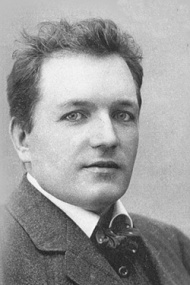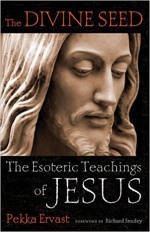User:SysopJ/My sandbox
ARTICLE UNDER CONSTRUCTION
ARTICLE UNDER CONSTRUCTION
Pekka Ervast (1875-1934) was founder of Finnish Section of Theosophical Society based in Adyar. He was a writer, lecturer and linguist.
Pekka Ervast was born on December 26, 1875, in Helsinki, Finland. His mother tongue was Swedish, and he belonged to the Lutheran Church like the vast majority of Finns did at the time. His father was a public officer; Ervast’s mother died when he was nine years old. Even as a child, he was very versatile in languages: for instance, he learnt to read French at the age of five or six, and at the age of twelve he began writing a comparative grammatical study of nine different languages.
He passed his matriculation exams in 1893 and started studying romance languages and Sanskrit at the University of Helsinki, which was known by a different name then. In January 1894, he got acquainted with Theosophy and next year joined the Scandinavian Section of the Theosophical Society. When the so-called Judge crisis broke, Ervast initially took Judge’s position in the dispute. The crisis in the Theosophical Society was painful to Ervast, who had believed in Universal Brotherhood, especially among theosophists. Meanwhile, Ervast valued highly Leo Tolstoy’s interpretation on the Sermon on The Mount, and he never gave up the ethics of the Sermon on the Mount. Ervast did not, however, accept Tolstoy’s very critical view on art, nor Tolstoy’s appreciation of physical labor as only true form of work.
Earnestly seeking for the meaning of life took Ervast eventually to point where he said: now comes clarity or death. And then in the year 1896 he went through an experience of rebirth, in which he was transformed by a pure light. This experience formed the basis for his theosophical work.
During the years 1896-1898, Ervast belonged to the Theosophical Society Point Loma and was its representative in Finland. He also joined the esoteric school led by Mrs. Tingley. Ervast intensively followed meditation instructions of the esoteric school. After a while he was able to do conscious occult investigation and work in the invisible world. For instance, he was able to observe various states in the afterlife (a compilation of his teachings on this topic is available in English as the e-book From Death to Rebirth).
In 1898, Ervast joined the Theosophical Society Adyar. He corresponded with many of the main theosophical workers in his time. For instance, he met General Olcott for the first time in 1900, and they got along very well. He also met the Countess Wachtmeister, who accompanied H. P. Blavatsky in her last years. The Countess warned Ervast from not entering politics in Finland.
Ervast started regular lecturing and writing on Theosophy early on in his theosophical career; theosophical work was his full-time occupation. It is worth noting that Theosophy in Finland attracted mainly persons belonging to the so-called working class, whereas in other parts of the Western world Theosophy was more popular among the higher classes. Ervast’s first book Towards Light (Valoa kohti) appeared in Finnish in 1901. It was an outline of a theosophical world view. The book is still in print, as are almost all his works which consist of more than 100 books (most of them are based on his lecture series). In addition, he translated theosophical books: C. W. Leadbeater’s The Other Side of Death appeared in Swedish in 1904 and Olcott’s A Buddhist Catechism in Finnish in 1906. Ervast was also one of the translators of H. P. B’s The Key to the Theosophy and parts of The Secret Doctrine. He became the first General Secretary of the Theosophical Society in Finland in 1907.
Ervast and other theosophists founded a commune Tuonenkylä in 1910.[1] The commune offered a home for Ervast for thirteen years. Almost thirty people lived in the commune over the years it was owned by the Finnish T. S.
The Order of the Star in the East was under intense interest among the theosophist in Finland and elsewhere. However, Rudolf Steiner, who was the Head of the German Section of the T. S. at the time, was very critical towards teachings of Krishnamurti as a newWorld Teacher. Ervast was also critical, but he would have preferred that different opinions could have co-existed in the T. S. Ervast met Steiner when he visited Helsinki in a lecture tour in 1912 just before Steiner left the T. S.
The outbreak of the First World War in 1914 was a great disappointment for Ervast. He had believed that theosophists on both sides of the war would follow the ideal of the universal brotherhood and declined to go to war. Ervast was an unconditional pacifist: according to his interpretation, the non-resistance of evil is the cornerstone of Esoteric Christianity (this is well in line with ahimsa in Hinduism and Buddha’s teachings on non-violence).
Ervast published two of his main works during the war time: The Esoteric School of Jesus (the contemporary translation is called The Divine Seed) and The Key to the Kalevala, which is available in English as a free ebook. The former is a detailed investigation of the ethical teachings of Jesus from the perspective of Esoteric Christianity, and the latter is an exploration of the spiritual meaning of the Finnish National Epic, the Kalevala.
There were two different lines of thought among the Finnish theosophists: one side believed that the T. S. should directly participate in society to advance brotherhood in practice, whereas Ervast and some others felt that the T. S. should remain spiritual in nature (naturally, members as citizens could be as active in society as they wished). These and other differences eventually caused Ervast to resign from the General Secretary post in 1917. In the same year Finland gained independency from Russia; Ervast had predicted this several years earlier. Unfortunately, next year the civil war broke in Finland which was a great sorrow for Ervast. He had believed that Finland could be the first country in the world which could live peacefully without weapons and army.
The year 1920 brought changes in Ervast’s life. Firstly, he joined to the Universal Co-Freemasonry (Le Droit Humain) and received the 33rd Degree Initiation in Paris five years later. Co-Freemasonry was very popular among the theosophist at the time, especially as Annie Besant and several other prominent theosophical leaders had joined it. Secondly, Ervast founded a new society, The Finnish Rosy Cross (Ruusu-Risti). The society has its roots both in Theosophy and Esoteric Christianity, in which the teachings of the Sermon on the Mount are crucial in the spiritual path. Ervast lectured on the special status of Jesus Christ in the spiritual evolution of humanity.[2] In some respects, his teaching on the Christ concur with Rudolf Steiner’s teachings. Naturally, all the great religions are highly valued as well.
Ervast wrote a letter The Mission of the Theosophical Society. An open letter to Theosophists the world over in 1921. The letter was aimed at to all theosophical societies and called for a common platform which would serve as a fraternal meeting point for all who share the same theosophical ideals. However, it didn’t receive much attention from the theosophical world.
Gottfried de Purucker from the Theosophical Society in Point Loma visited Helsinki in 1931. He proposed that the Finnish Rosy Cross could join the Point Loma society. His proposal was not accepted, although the meeting in Helsinki was cordial.
Ervast remained prolific to the end of his life. For instance, he published the book The Sermon on the Mount (the Finnish version appeared in 1925) and the play H. P. B in 1933 in English. The book attracted several reviews, such as News and Notes (Sidney, by K. B.), The Occult Review (London, by Frank Lind) and The Aryan Path (Bombay, by Swami Jagadiswarananda). The play was reviewed in The Occult Review (by J. F. Lawrence).
Ervast spent the winter 1933-1934 in Ojai, California. He wrote his final book, The Great Adventure, in California. Ervast called the book as his swan song. He came back to Finland in May 1934 and died soon after his return. Ervast had a significant impact on the Finnish cultural life: for instance, many artists received inspiration from his teachings. His legacy lives on in Finland within several groups dedicated to his teachings.
Writings in English
- From Death to Rebirth. Literary Society of the Finnish Rosy Cross, 2017. Compiled and edited by Jouni Marjanen, Antti Savinainen, and Jouko Sorvali. Foreword by Richard Smoley. This is also available as an audio book: https://www.youtube.com/watch?v=9yE4QrLY9v4.
- The Divine Seed: The Esoteric Teachings of Jesus. Second edition published by Quest Books, 2010. Reviewed in TheoSophia (NZ) 72.4 (Summer, 2011), 29.
- The Key to the Kalevala. 1916. (The English version was first published in 1999 by Blue Dolphin Publishing and the e-book version in 2018 by Literary Society of the Finnish Rosy Cross). https://www.teosofia.net/e-kirjat/Pekka_Ervast_-_The_Key_to_the_Kalevala.pdf
- The Mission of the Theosophical Society. 1921. http://media.pekkaervast.net/penet/books_files/The_Mission_of_the_Tehosophical_Society.pdf
- Astral Schools. 1929. (The English e-book version was published in 2008 by www.pekkaervast.net) http://media.pekkaervast.net/penet/books_files/astral_schools.pdf
- The Sermon on the Mount. 1933. http://media.pekkaervast.net/penet/books_files/The_Sermon_on_the_Mount_or_The_Key_to_Christianity.pdf
- H. P. B.: The Sphinx of the XIXth Century. 1933. http://media.pekkaervast.net/penet/books_files/HPB_The_Sphinx_of_the_XIXth_Century.pdf
Additional resources
- Ervast, Pekka. "Reports of the TS in Finland" The Theosophist v39 (July, 1918), 392.
- General Reports of the Theosophical Society provide reports written by Pekka Ervast during the years that he was leader of the Finnish Section of the TS Adyar.
- PekkaErvast.net. Website in Finnish.
Notes
<references/?

